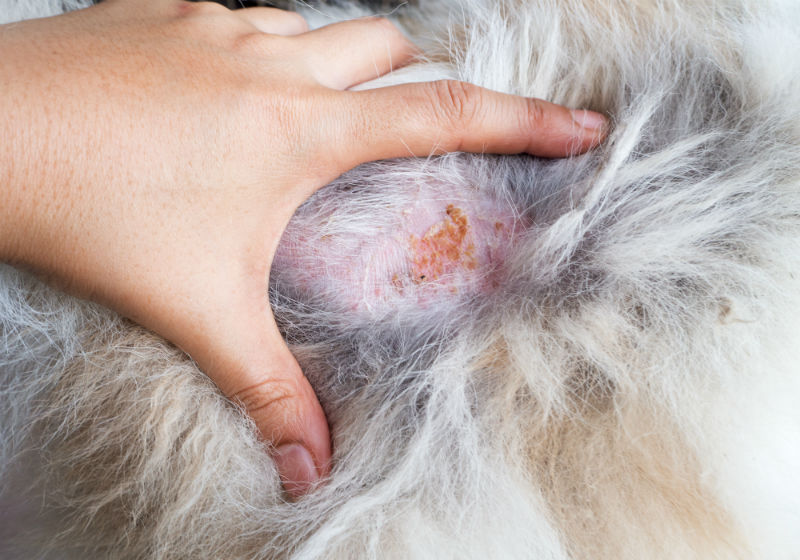Treat infections – Before doing anything else, it is essential to clear up secondary infections. Secondary infections involve bacteria (usually Staphylococcal) and yeast (Malassezia) at the site of the itchiest areas on the body. These organisms live naturally in the skin, but when the skin is irritated, they gain access to inner tissue layers and proliferate. Sometimes they come to generate a further allergic response in the skin. These infections tend to recur and are the usual cause of recurrence of itch symptoms in a patient who was previously controlled. Many patients will not be particularly itchy in between infection flare-ups, so it is especially important that these be controlled.
Hyposensitization (Allergen Specific Immunotherapy), more commonly known as allergy shots, is by far the treatment of choice for atopic dermatitis. All the other medications are just itch-relief; only hyposensitization changes the immune system. Some dogs are eventually able to go off all treatment and are no longer allergic after they have been on hyposensitization long enough. Most dogs are at least much better and require fewer additional treatments.
- Allergy injections require approximately 6 to 12 months to begin working.
- 25% of atopic dogs will not respond (these are usually the animals allergic to multiple allergens.)
- 25% will require a corticosteroid like prednisone or similar medication at least at sometimes.
- You will most likely have to give the allergy injections yourself.
- Referral to a veterinary dermatologist will likely be necessary.
- Hyposensitization involves the patient being injected with small amounts of allergens on a regular basis. As time passes, the quantities of allergens increase and injections are given at longer intervals. The selection of allergens is made based on the results of either an intradermal skin test or an in vitro test (a blood test) or a combination of the results of both tests. The younger the pet is when this treatment starts, the better it works.
Corticosteroid Hormones
These cortisone-type medications (prednisone, prednisolone, triamcinolone, dexamethasone etc.) tend to be used as the first line of defence against itchy skin. A higher dose is used at first, but this is quickly tapered down once the condition is controlled. Prednisone, for example, is given every other day to allow the pet one day of recovery from the prednisone’s hormonal actions. An atopic pet will usually respond within days.
Common side effects: Excess thirst, excess urination, which could lead to house-breaking issues, excess hunger, suppression of the immune-system/bringing out latent infection, especially urinary tract infection and upper respiratory infection, raising blood sugar/destabilizing a borderline diabetic (especially a problem for cats if long-acting injectable steroids are used). In the short term, side effects can be controlled by adjusting dosage but in the long term, these medications are more problematic, and if possible their use is minimized.
Corticosteroids are useful for acute flare-ups as well as for long-term management of atopic dermatitis (assuming limits are placed on how long they are used).
Cyclosporine (Atopica)
Cyclosporine is a modulator of the immune response that has been helpful in both human and non-human organ transplant patients. It has been found to be reliably effective in atopic dermatitis and does not carry the unpleasant side effect profile that corticosteroids do. That said, it is not without side effects of its own. It is used mostly in dogs but can also be used in cats. It is for long-term management and is not helpful for acute flare-up control.
Oclacitinib (Apoquel)
This is a new medication best used for itch relief and blocking itch symptoms. It is popular as it works fast. It does not address the inflammation of the skin; it just stops the itch sensation. This means that infection still needs to be controlled. For more details visit Apoqueldogs.com.
Canine Atopic Dermatitis Immunotherapeutic (Cytopoint®) Injections
This is a new treatment that uses vaccine technology to eliminate one of the principal mediators of itch sensation. The injections provide relief from itching for one month to 80 percent of dogs and show effectiveness usually within 24 hours of the injection. For many dogs, relief of itch stops the vicious cycle of itch/infection. Again, any infections still need treatment, but the sensation of itch is usually controlled.
Proper Coat Hygiene/Removing Allergens from the Environment if Possible:
- Bathing the pet weekly to remove allergens from the fur may be helpful in reducing allergen exposure plus tepid water is soothing to itchy skin. There are also many therapeutic shampoos that can be used to restore the skin’s natural barrier or to assist in general itch relief.
- Avoid stuffed toys, wash bedding regularly. This minimizes dust mite exposure. Also, remove the pet from the area when vacuuming or dusting.
- Use air-conditioning or an air filter system.
- Keep the pet away from the lawn while it is being mowed.
- Minimize houseplants.
- Omega 3 Fatty Acid Supplements -These products are NOT just adding oil to the pet’s food. Instead, these unique fatty acids act as medications, disrupting the production of inflammatory chemicals within the skin. By using these supplements, it may be possible to postpone the need for corticosteroids or reduce the dose of steroid needed to control symptoms. It takes a good six weeks to build up enough omega three fatty acids in the body to see a difference.
Antihistamines
Antihistamines have been popular for many years for pets, and yet their effectiveness is variable. They do not provide short-term relief or reliable long-term relief. They may be helpful in combination with other products in that their use may reduce the need for additional products. They may work better in cats than in dogs.
Effective Flea Control
Allergies are additive. This means that when a patient has multiple allergies, each allergy alone may not be enough to cause itching but the allergies all active together probably will. Consequently, taking away one of the active allergies may be enough to allergy reduction to resolve the itching. Flea bite allergy is extremely common. We now have so many effective products available that there is no reason for an animal to contend with a flea bite allergy. This simple bit of therapy (flea control) may be enough to bring the pet below the itch threshold without having to contend with any of the therapies listed above.
Itchy skin is not a recent phenomenon in dogs and cats. We are now armed with an excellent understanding of immunology and have many treatment modalities to address allergy symptoms. Consult your veterinarian about a proper regimen.
Reference – VIN.com (Veterinary Information Network)
Written by Alex Hare, DVM




